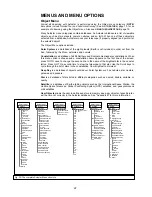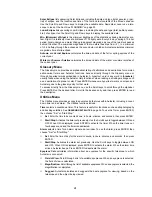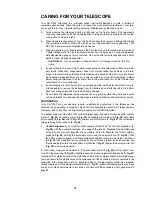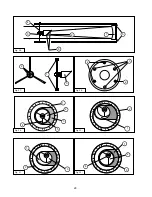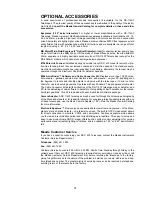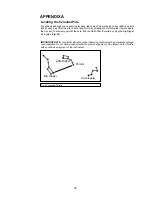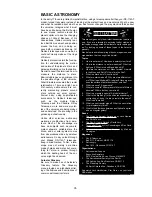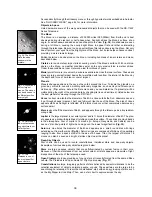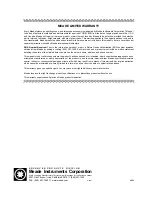
36
Access directly through the Glossary menu or through hypertext words embedded in Autostar.
See “GLOSSARY MENU," page 24, for more information.
Objects in Space
Listed below are some of the many astronomical objects that can be seen with the DS-114AT
Series Telescope:
The Moon
The Moon is, on average, a distance of 239,000 miles (380,000km) from Earth and is best
observed during its crescent or half phase when Sunlight strikes the Moon’s surface at an
angle. It casts shadows and adds a sense of depth to the view (Fig. 34). No shadows are seen
during a full Moon, causing the overly bright Moon to appear flat and rather uninteresting
through the telescope. Be sure to use a neutral Moon filter when observing the Moon. Not only
does it protect your eyes from the bright glare of the Moon, but it also helps enhance contrast,
providing a more dramatic image.
Brilliant detail can be observed on the Moon, including hundreds of lunar craters and maria,
described below.
Craters are round meteor impact sites covering most of the Moon’s surface. With no atmos-
phere on the Moon, no weather conditions exist, so the only erosive force is meteor strikes.
Under these conditions, lunar craters can last for millions of years.
Maria (plural for mare) are smooth, dark areas scattered across the lunar surface. These dark
areas are large ancient impact basins that were filled with lava from the interior of the Moon by
the depth and force of a meteor or comet impact.
Planets
Planets change positions in the sky as they orbit around the Sun. To locate the planets on a
given day or month, consult a monthly astronomy magazine, such as Sky and Telescope or
Astronomy. (Tip: enter a date in the Date menu and you can determine if a planet(s) will be
visible during the night of the entered date by checking its rise and set times). Listed below are
the best planets for viewing through the DS-114AT.
Venus is about nine-tenths the diameter of Earth. As Venus orbits the Sun, observers can see
it go through phases (crescent, half, and full) much like those of the Moon. The disk of Venus
appears white as Sunlight is reflected off the thick cloud cover that completely obscures any
surface detail.
Mars is about half the diameter of Earth, and appears through the telescope as a tiny reddish-
orange disk.
Jupiter is the largest planet in our solar system and is 11 times the diameter of Earth. The plan-
et appears as a disk with dark lines stretching across the surface. These lines are cloud bands
in the atmosphere. Four of Jupiter’s 16 moons (Io, Europa, Ganymede, and Callisto) can be
seen as “star-like” points of light when using even the lowest magnification (Fig. 35).
Saturn is nine times the diameter of Earth and appears as a small, round disk with rings
extending out from either side (Fig. 36). Saturn’s rings are composed of billions of ice particles
ranging in size from a speck of dust to the size of a house. Titan, the largest of Saturn’s 18
moons can also be seen as a bright, star-like object near the planet.
Deep-Sky Objects
Star charts can be used to locate constellations, individual stars and deep-sky objects.
Examples of various deep-sky objects are given below:
Stars are large gaseous objects that are self-illuminated by nuclear fusion in their core.
Because of their vast distances from our solar system, all stars appear as pinpoints of light,
irrespective of the size of the telescope used.
Open Clusters are loose groupings of young stars, all recently formed from the same diffuse
nebula. The Pleiades is an open cluster 410 light years away (Fig. 37).
Constellations are large, imaginary patterns of stars believed by ancient civilizations to be the
celestial equivalent of objects, animals, people, or gods. These patterns are too large to be
seen through a telescope. To learn the constellations, start with an easy grouping of stars, such
as the Big Dipper in Ursa Major. Then, use a star chart to explore across the sky.
Fig. 36: Saturn has
the most extensive
ring structure in our
Solar System.
Fig. 37: The
Pleiades is one of
the most beautiful
open clusters.
Fig. 35: Jupiter and
its four largest
moons. The moons
can be observed in
a different position
every night.
Fig. 34: The Moon.
Note the deep
shadows in the
craters.

